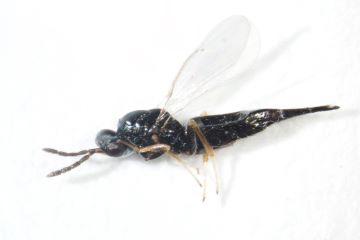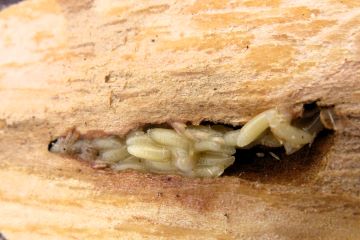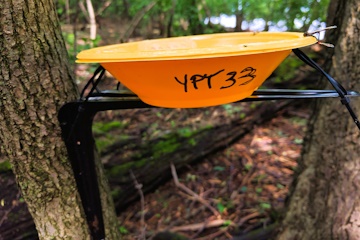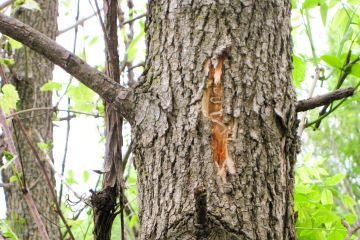Emerald Ash Borer Biocontrol Research & Implementation - Phase 1
Project Partners: Robert Venette (1 and 2), Brian Aukema (1), Jonathan Osthus (3) and Monika Chandler (3)
Project Period: 07/01/2011 - 06/30/2014
We made great progress with the biological control for emerald ash borer (EAB) in Phase 1 of this project. We simultaneously released wasps that parasitize EAB while we studied them. EAB can kill ash trees quickly (within five years). We have responded rapidly to EAB finds so that we might avoid large numbers of EAB over extensive areas, a situation that would be difficult to manage effectively. At the same time, we studied the parasitoid wasps to understand their cold tolerance and dispersal capability. Our studies improved our implementation strategies.
Over 127,000 parasitoid wasps were released at 21 sites in the Twin Cities and southeastern Minnesota. Recovery of immature parasitoids in the field demonstrated that these agents are dispersing then finding and parasitizing EAB. We will continue releases in Phase 2. Research efforts demonstrated that the egg parasitoid, Oobius agrili, is the most cold tolerant and the larval parasitoid, Tetrastichus planipennisi, is the least cold tolerant. Therefore, we began releasing T. planipennisi earlier in the season to allow multiple generations to build a population sufficient to withstand anticipated cold induced mortality losses. We learned that T. planipennisi is capable of dispersing almost 5 miles within 24 hours but that most will fly ¾ miles in 24 hours. Therefore, we began releasing T. planipennisi over a large area at a release site rather than at a central cluster to enable faster T. planipennisi dispersal. Research efforts trained a total of six graduate students, five undergraduate students and three technicians in whole or in part on these projects.
We will continue a study of ash health, EAB and parasitoid wasps in the Twin Cities area where EAB was first found in 2009. To date, ash mortality within the study area has been substantially lower than anticipated.
Summary of Project Findings:
We made great progress with the biological control for emerald ash borer (EAB) in Phase 1 of this project. We simultaneously released wasps that parasitize EAB while we studied them. EAB can kill ash trees quickly (within 6 years). We have responded rapidly to EAB finds so that we might avoid large numbers of EAB over extensive areas, a situation that would be difficult to manage effectively. At the same time, we studied the parasitoid wasps to understand their cold tolerance and dispersal capability. Our studies improved our implementation strategies.
Over 127,000 parasitoid wasps were released at 21 sites in the Twin Cities and southeastern Minnesota. Recovery of immature parasitoids in the field demonstrated that these agents are dispersing then finding and parasitizing EAB. We will continue releases in Phase 2. Research efforts demonstrated that the egg parasitoid, Oobius agrili, is the most cold tolerant and the larval parasitoid, Tetrastichus planipennisi, is the least cold tolerant. Therefore, we began releasing T. planipennisi earlier in the season to allow multiple generations to build a population sufficient to withstand anticipated cold induced mortality losses. We learned that T. planipennisi is capable of dispersing almost 5 miles within 24 hours but that most will fly ¾ miles in 24 hours. Therefore, we began releasing T. planipennisi over a large area at a release site rather than at a central cluster to enable faster T. planipennisi dispersal. Research efforts trained a total of six graduate students, five undergraduate students and three technicians in whole or in part on these projects.
We will continue a study of ash health, EAB and parasitoid wasps in the Twin Cities area where EAB was first found in 2009. To date, ash mortality within the study area has been substantially lower than anticipated.
Affiliations:
- University of Minnesota
- USDA Forest Service
- Minnesota Department of Agriculture
We made great progress with the biological control for emerald ash borer (EAB) in Phase 1 of this project. We simultaneously released wasps that parasitize EAB while we studied them. EAB can kill ash trees quickly (within five years). We have responded rapidly to EAB finds so that we might avoid large numbers of EAB over extensive areas, a situation that would be difficult to manage effectively. At the same time, we studied the parasitoid wasps to understand their cold tolerance and dispersal capability. Our studies improved our implementation strategies.
Over 127,000 parasitoid wasps were released at 21 sites in the Twin Cities and southeastern Minnesota. Recovery of immature parasitoids in the field demonstrated that these agents are dispersing then finding and parasitizing EAB. We will continue releases in Phase 2. Research efforts demonstrated that the egg parasitoid, Oobius agrili, is the most cold tolerant and the larval parasitoid, Tetrastichus planipennisi, is the least cold tolerant. Therefore, we began releasing T. planipennisi earlier in the season to allow multiple generations to build a population sufficient to withstand anticipated cold induced mortality losses. We learned that T. planipennisi is capable of dispersing almost 5 miles within 24 hours but that most will fly ¾ miles in 24 hours. Therefore, we began releasing T. planipennisi over a large area at a release site rather than at a central cluster to enable faster T. planipennisi dispersal. Research efforts trained a total of six graduate students, five undergraduate students and three technicians in whole or in part on these projects.
We will continue a study of ash health, EAB and parasitoid wasps in the Twin Cities area where EAB was first found in 2009. To date, ash mortality within the study area has been substantially lower than anticipated.
Summary of Project Findings:
We made great progress with the biological control for emerald ash borer (EAB) in Phase 1 of this project. We simultaneously released wasps that parasitize EAB while we studied them. EAB can kill ash trees quickly (within 6 years). We have responded rapidly to EAB finds so that we might avoid large numbers of EAB over extensive areas, a situation that would be difficult to manage effectively. At the same time, we studied the parasitoid wasps to understand their cold tolerance and dispersal capability. Our studies improved our implementation strategies.
Over 127,000 parasitoid wasps were released at 21 sites in the Twin Cities and southeastern Minnesota. Recovery of immature parasitoids in the field demonstrated that these agents are dispersing then finding and parasitizing EAB. We will continue releases in Phase 2. Research efforts demonstrated that the egg parasitoid, Oobius agrili, is the most cold tolerant and the larval parasitoid, Tetrastichus planipennisi, is the least cold tolerant. Therefore, we began releasing T. planipennisi earlier in the season to allow multiple generations to build a population sufficient to withstand anticipated cold induced mortality losses. We learned that T. planipennisi is capable of dispersing almost 5 miles within 24 hours but that most will fly ¾ miles in 24 hours. Therefore, we began releasing T. planipennisi over a large area at a release site rather than at a central cluster to enable faster T. planipennisi dispersal. Research efforts trained a total of six graduate students, five undergraduate students and three technicians in whole or in part on these projects.
We will continue a study of ash health, EAB and parasitoid wasps in the Twin Cities area where EAB was first found in 2009. To date, ash mortality within the study area has been substantially lower than anticipated.
Affiliations:
- University of Minnesota
- USDA Forest Service
- Minnesota Department of Agriculture
We made great progress with the biological control for emerald ash borer (EAB) in Phase 1 of this project. We simultaneously released wasps that parasitize EAB while we studied them. EAB can kill ash trees quickly (within five years). We have responded rapidly to EAB finds so that we might avoid large numbers of EAB over extensive areas, a situation that would be difficult to manage effectively. At the same time, we studied the parasitoid wasps to understand their cold tolerance and dispersal capability. Our studies improved our implementation strategies.
Over 127,000 parasitoid wasps were released at 21 sites in the Twin Cities and southeastern Minnesota. Recovery of immature parasitoids in the field demonstrated that these agents are dispersing then finding and parasitizing EAB. We will continue releases in Phase 2. Research efforts demonstrated that the egg parasitoid, Oobius agrili, is the most cold tolerant and the larval parasitoid, Tetrastichus planipennisi, is the least cold tolerant. Therefore, we began releasing T. planipennisi earlier in the season to allow multiple generations to build a population sufficient to withstand anticipated cold induced mortality losses. We learned that T. planipennisi is capable of dispersing almost 5 miles within 24 hours but that most will fly ¾ miles in 24 hours. Therefore, we began releasing T. planipennisi over a large area at a release site rather than at a central cluster to enable faster T. planipennisi dispersal. Research efforts trained a total of six graduate students, five undergraduate students and three technicians in whole or in part on these projects.
We will continue a study of ash health, EAB and parasitoid wasps in the Twin Cities area where EAB was first found in 2009. To date, ash mortality within the study area has been substantially lower than anticipated.
Summary of Project Findings:
We made great progress with the biological control for emerald ash borer (EAB) in Phase 1 of this project. We simultaneously released wasps that parasitize EAB while we studied them. EAB can kill ash trees quickly (within 6 years). We have responded rapidly to EAB finds so that we might avoid large numbers of EAB over extensive areas, a situation that would be difficult to manage effectively. At the same time, we studied the parasitoid wasps to understand their cold tolerance and dispersal capability. Our studies improved our implementation strategies.
Over 127,000 parasitoid wasps were released at 21 sites in the Twin Cities and southeastern Minnesota. Recovery of immature parasitoids in the field demonstrated that these agents are dispersing then finding and parasitizing EAB. We will continue releases in Phase 2. Research efforts demonstrated that the egg parasitoid, Oobius agrili, is the most cold tolerant and the larval parasitoid, Tetrastichus planipennisi, is the least cold tolerant. Therefore, we began releasing T. planipennisi earlier in the season to allow multiple generations to build a population sufficient to withstand anticipated cold induced mortality losses. We learned that T. planipennisi is capable of dispersing almost 5 miles within 24 hours but that most will fly ¾ miles in 24 hours. Therefore, we began releasing T. planipennisi over a large area at a release site rather than at a central cluster to enable faster T. planipennisi dispersal. Research efforts trained a total of six graduate students, five undergraduate students and three technicians in whole or in part on these projects.
We will continue a study of ash health, EAB and parasitoid wasps in the Twin Cities area where EAB was first found in 2009. To date, ash mortality within the study area has been substantially lower than anticipated.
Affiliations:
- University of Minnesota
- USDA Forest Service
- Minnesota Department of Agriculture
Biosurveillance and Biocontrol of Emerald Ash Borer - Phase 2
Project Partners: Robert Venette (1 and 2), Brian Aukema (1), Angela Gupta (1), Jeffrey Hahn (1), Jennifer Schultz (1), Cy Kosel (3), Rachel Coyle (3), Ralph Sievert (4), Philip Potyondy (4), Jonathan Osthus (5) and Monika Chandler (5)
Project Period: 07/01/2014 - 06/30/2017
Emerald ash borer (EAB) biological control uses parasitoid wasps to reduce EAB populations and is still experimental in practice. However, biological control is the only practical EAB management strategy for natural forest ash and is a component of urban EAB management. We will improve biological control implementation with the following.
- Biosurveillance of EAB: Engage citizen scientist volunteers to monitor EAB populations statewide using a native wasp, the smoky winged beetle bandit. This harmless wasp specifically hunts metallic wood boring beetles (buprestids) including EAB as food for their offspring. Citizen scientists can survey the type of beetle prey the wasps are capturing and help with early detection of EAB if it is present in the area. Our goals are to better delimit EAB populations and educate the public about EAB. Additionally, biosurveillance will monitor for similar high risk wood-boring beetles that are not documented in Minnesota. More information about biosurveillance
- Track EAB infestation core: Continue monitoring ash health, EAB and EAB biological control agents in the core infested area of the Twin Cities. This study was initiated in 2011 and will provide answers about the importance of multiple management activities.
- Expand biological control implementation: Biological control was initiated in 2010 and biological control agents have been released at most known infestations. EAB is spreading so new detections are inevitable. The biological control effort will be expanded to address new EAB finds and continue existing site monitoring.
Summary of project findings:
Emerald ash borer populations remain surprisingly low in the Twin Cities and EAB has not spread as quickly in Minnesota as other states. This is likely due to a combination of factors that include the activities of this project. One factor is the early detection and rapid response to new EAB infestations. Detection with biosurveillance, branch sampling and visual inspection conducted in our project enabled early detection of new finds through branch sampling (20 trees in 2011, 18 trees in 2012, 30 trees in 2013, 21 trees in 2014, 35 trees in 2015 and 32 trees in 2016), biosurveillance (1 EAB find in 2016 and 3 in 2017 – in July but were a result of this project) and visual inspection (hundreds of infested trees are found throughout the year when helping cities delimit newly identified infestations). A growing number of citizen scientists were involved with biosurveillance with 12 in 2014, 51 in 2015 and 65 in 2016. EAB mortality due to extreme cold during the winter of 2013-2014 was a factor. Another factor is that the public and industry have avoided moving infested wood. Whether biological control is a factor for EAB management remains unknown. A total of 450,000 larval and egg parasitoids were released at 33 sites during Phases 1 and 2 of this project. We are pleased that we documented established, reproducing populations at five sites in two counties. To document this, both larval parasitoids and the egg parasitoids were recovered with methods involving debarking ash branches and trunks, bark sifting, yellow pan traps and larval dissection. We also documented a native parasitoid, Atanycolus simplex, which can also attack EAB.
Affiliations:
- University of Minnesota
- USDA Forest Service
- City of St. Paul Parks and Recreation
- Minneapolis Park and Recreation Board
- Minnesota Department of Agriculture





